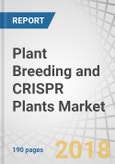Plant Breeding and CRISPR Plants Market by Type (Conventional and Biotechnological [Hybrid, Molecular Breeding, GM, Genome Editing]), Trait (Herbicide Tolerance, Disease Resistance, and Yield Improvement), Application, and Region - Global Forecast to 2023
The plant breeding and CRISPR plants market is projected to grow at a CAGR of 13.95% from 2018 to 2023.
The plant breeding and CRISPR plants market is projected to reach USD 14.6 billion by 2023, from USD 7.6 billion in 2018, at a CAGR of 13.95%. The plant breeding and CRISPR plants market is driven by various factors such as increasing demand for improved crop varieties using modern breeding technologies and advancements in breeding techniques. However, the inconsistent regulatory implications on genetic modification techniques across regions may hinder the growth of the market on a global level.
In terms of type, the biotechnological method is projected to witness the fastest growth from 2018 to 2023.
With the improving economic conditions of the Asian and African countries, the adoption rate of biotechnological methods remains high. Though the price for conventional breeding techniques is projected to be feasible in developing economies such as Thailand, Nigeria, Philippines, Kenya, and Indonesia, the declining prices of genetic services are projected to bridge the price gap between conventional and biotechnological methods. This is projected to enhance the growth opportunity for the biotechnological methods segment during the forecast period. Further, though the US appears to be a mature market, the withdrawal of regulations on CRISPR-edited corn has boosted the growth opportunity in the country.
In terms of trait, the herbicide tolerance segment is estimated to have the largest market share during the forecast period.
According to the USDA, an increasing number of producers have been adopting herbicide-tolerant seeds for corn and rice cultivation in the country. Players such as Syngenta and BASF are focusing on developing plant breeding technologies, such as Clearfield technology to develop non-transgenic and hybrid pesticide-tolerant plant varieties. Moreover, the recent product launches on commercial seeds majorly involve herbicide tolerance as one of the major traits. Hence, the herbicide tolerance dominated the market and is projected to record the fastest growth compared to other traits during the forecast period.
North America is estimated to dominate the plant breeding and CRISPR plants market in 2018.
According to ISF, in 2016, North America, especially the US, led the commercial seeds market. Also, the US was the second major exporter of commercial seeds across the globe, according to ISF statistics in 2016. As per the USDA estimates, the US contributes nearly 54% of the global R&D invested for crop seed development every year. The increasing industrial value for corn and soybean in the US is encouraging breeders to adopt advanced technologies for better yield, owing to which the adoption rate for genetics in this country remains high, and hence, North America dominated the market for plant breeding and CRISPR plants in 2018.
In-depth interviews were conducted with Chief Executive Officers (CEOs), marketing directors, other innovation and technology directors, and executives from various key organizations operating in the plant breeding marketplace.
The breakdown of the primaries on the basis of company type, designation, and region conducted during the research study is as follows:
- By Company type: Tier 1 – 45%, Tier 2 –30%, and Tier 3 – 25%
- By Designation: C-Level – 50%, D-Level – 20%, and Others* – 30%
- By Region: Asia Pacific – 40%, Europe –30%, North America –20%, and RoW -10%
*Others include sales managers, marketing managers, and product managers.
Note: Tier 1: Revenue > USD 1 billion; Tier 2: USD 100 million ≤ Revenue ≤ USD 1 billion; Tier 3: Revenue < USD 100 million
The global market for plant breeding and CRISPR plants is dominated by the in-house plant breeding market rather than service providers. Companies such as Bayer (Germany), Syngenta (Switzerland), KWS (Germany), and DowDuPont (US) utilize combinations of both traditional and molecular breeding to develop various seed traits, whereas companies such as Eurofins (Luxembourg) and SGS (Switzerland) provide services to certain seed companies.
Research Coverage
The report analyzes the plant breeding and CRISPR plants market across different types and regions. It aims at estimating the market size and growth potential of this market across different segments, such as type, trait, application, and region. Furthermore, the report includes an in-depth competitive analysis of key players in the market, along with their company profiles, recent developments, and key market strategies.
Key Benefits
The report will help the market leaders/new entrants in this market by providing them the closest approximations of revenue numbers for the overall plant breeding market and its subsegments. This report will help stakeholders to better understand the competitor landscape, gain more insights to position their businesses better and devise suitable go-to-market strategies. The report will also help stakeholders to understand the market and provide them with information on key market drivers, restraints, challenges, and opportunities.
Table of Contents
Companies Mentioned
- Advanta Seeds (UPL)
- Bayer
- Benson Hill Biosystems
- Bioconsortia
- DLF
- Dowdupont
- Equinom
- Eurofins
- Evogene
- Groupe Limagrain
- Hudson River Biotechnology
- KWS Group
- Land O’lakes (Forage Genetics International)
- Pacific Biosciences
- SGS (Traitgenetics)
- Syngenta
Table Information
| Report Attribute | Details |
|---|---|
| No. of Pages | 190 |
| Published | December 2018 |
| Forecast Period | 2018 - 2023 |
| Estimated Market Value ( USD | $ 7.6 billion |
| Forecasted Market Value ( USD | $ 14.6 billion |
| Compound Annual Growth Rate | 13.9% |
| Regions Covered | Global |
| No. of Companies Mentioned | 16 |









